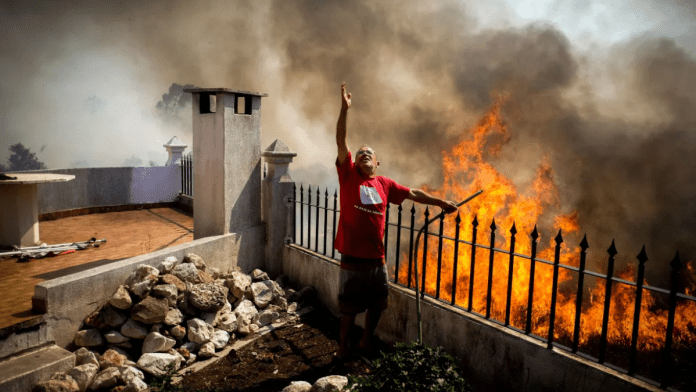🕒 Last updated on August 7, 2025
It’s only 6 a.m., and parts of Portugal are already feeling like an oven. In some places, the day begins at nearly 30ºC, and the heat barely lets up through the night. Sleep becomes nearly impossible.
Heat grips Portugal as temperatures soar past 40°C
Across the country, temperatures are soaring above 40ºC in multiple regions. The cause is a powerful anticyclone parked over the Iberian Peninsula, locking in hot, dry air. This weather pattern is forcing Portugal into what may be the hottest August in the previous 15 to 20 years, according to analysts.
For many communities, the heat is not just uncomfortable—it’s dangerous. More than 150 municipalities, mostly in the north, central interior, and Algarve regions, are now at the highest level of fire risk. The red alert remains in place, and the combination of heat, dry air, and wind is creating the perfect conditions for wildfires to spread.
Yesterday, on August 4, firefighters were battling 32 active fires, according to the Portuguese Civil Protection Authority. The biggest fire in the north is still raging through the Minho region, impacting Fafe, Vila Real, and Celorico de Basto. In the Braga district, flames forced the closure of the A7 highway in both directions.
🧱 Finland builds world’s largest sand battery — and it’s heating homes without oil or pollution
The situation is grim, and for now, there is little relief in sight. Forecasts suggest this heat wave will grip the country for days to come, potentially lasting until mid-August.
Wildfires spread as red alerts remain in place
The fires now burning across Portugal are not isolated incidents. They are part of a pattern that repeats almost every summer but is becoming more intense with each passing year. The extreme heat is drying out vegetation, turning forests and grasslands into tinderboxes.
In the north, smoke and flames have forced evacuations in some areas. Entire hillsides glow orange at night as fire crews work tirelessly to hold the lines. Helicopters and planes drop water from above, while ground teams cut firebreaks and try to stop the flames from reaching homes.
The Civil Protection Authority has kept the country on high alert, urging residents to avoid activities that could spark fires. Even a small spark from machinery or a discarded cigarette can ignite dry brush and trigger a fast-moving blaze.
The fires this summer are putting Portugal’s firefighting capabilities to the test. Crews are stretched thin as multiple large fires burn at the same time. In some cases, teams must be redeployed from one fire to another as conditions change.
🌊 Freshwater Vanishing at Alarming Speed — Four Mega-Regions Face Collapse
Authorities say the heat wave is playing a major role in the intensity of the fires. High temperatures, combined with low humidity and gusty winds, make it harder to bring the flames under control.
For rural communities, the risk is constant. Farmers are seeing their fields and pastures scorched. Roads are closed, and smoke makes breathing difficult even in towns far from the fire fronts.
Portugal is among the most vulnerable to heat waves in Europe
Portugal’s location on the Iberian Peninsula makes it especially vulnerable to extreme summer heat. The country is part of the Mediterranean basin, which scientists say is one of the world’s fastest-warming regions. This means heat waves here are becoming hotter, longer, and more frequent.
According to the European Environment Agency, Southern European countries like Portugal face the most severe risks from climate change compared to other parts of the continent. Not only are the temperatures rising faster here, but there are also fewer options to reduce the impact.
🌐Satellite Termination Order Sparks Climate Data Crisis —$15M saves pennies, costs the planet
Average annual temperatures in the Iberian Peninsula have already risen by 1.5ºC above pre-industrial levels—a rate about 20% faster than the global average. Projections show that summer warming in the region could be 40–50% higher than global annual warming rates.
This year’s heat wave is another reminder of this trend. The synoptic weather patterns driving the current extreme temperatures are expected to become more common in the years ahead.
The Mediterranean climate, with its dry summers, is naturally prone to heat waves. But the scale and intensity now being recorded are pushing it into dangerous territory. These conditions fuel wildfires, damage crops, stress water supplies, and affect health—especially for older adults and vulnerable communities.
Portugal’s firefighting forces, emergency responders, and communities are now facing the challenge head-on. While the heat wave continues, so too does the risk of more fires breaking out. For now, the country remains on edge, watching the skies darken with smoke as temperatures refuse to drop.

